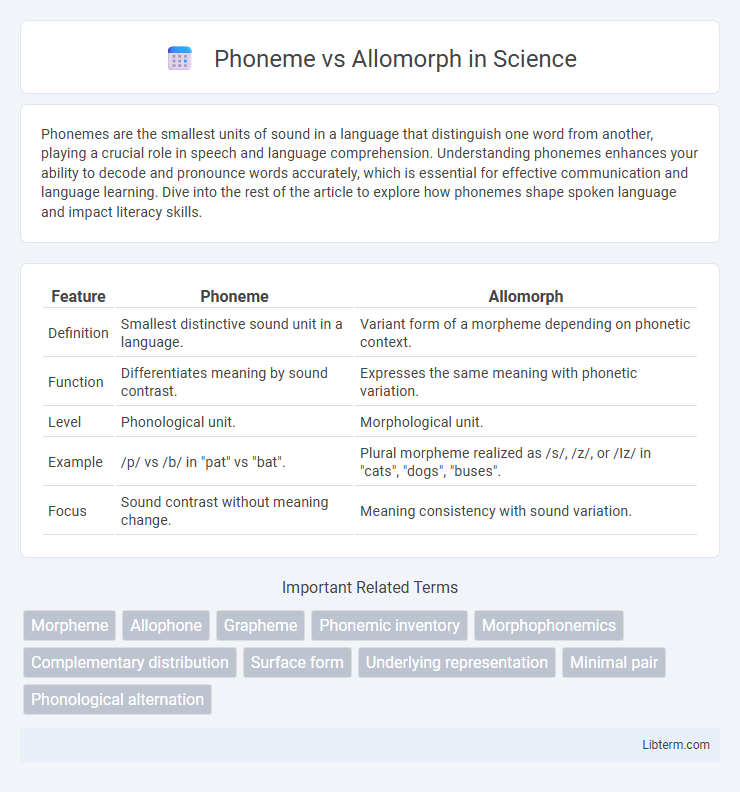Phonemes are the smallest units of sound in a language that distinguish one word from another, playing a crucial role in speech and language comprehension. Understanding phonemes enhances your ability to decode and pronounce words accurately, which is essential for effective communication and language learning. Dive into the rest of the article to explore how phonemes shape spoken language and impact literacy skills.
Table of Comparison
| Feature | Phoneme | Allomorph |
|---|---|---|
| Definition | Smallest distinctive sound unit in a language. | Variant form of a morpheme depending on phonetic context. |
| Function | Differentiates meaning by sound contrast. | Expresses the same meaning with phonetic variation. |
| Level | Phonological unit. | Morphological unit. |
| Example | /p/ vs /b/ in "pat" vs "bat". | Plural morpheme realized as /s/, /z/, or /Iz/ in "cats", "dogs", "buses". |
| Focus | Sound contrast without meaning change. | Meaning consistency with sound variation. |
Introduction to Phonemes and Allomorphs
Phonemes serve as the smallest distinctive sound units in a language, crucial for differentiating meanings between words. Allomorphs represent variant forms of a single morpheme that appear in different phonetic contexts without altering the original meaning. Understanding phonemes and allomorphs aids in analyzing language structure, pronunciation patterns, and morphological variations.
Defining Phoneme: The Building Blocks of Speech
A phoneme is the smallest distinctive sound unit in a language that can change meaning, serving as the fundamental building block of speech. Unlike allomorphs, which are variant forms of a morpheme, phonemes function at the sound level without inherent semantic content. Understanding phonemes is essential for phonology and language acquisition, as they enable the differentiation of words through sound contrasts.
Understanding Allomorphs: Variations in Morphemes
Allomorphs represent the variations of a single morpheme that appear in different phonetic or contextual environments without changing the morpheme's meaning. These variations exemplify how morphemes adapt their pronunciation or form, such as the English plural morpheme appearing as /s/, /z/, or /Iz/ in cats, dogs, and horses respectively. Understanding allomorphs is essential in morphology because it reveals the interplay between phonology and word formation processes within a language.
Phoneme vs Allomorph: Key Differences
Phonemes are the smallest units of sound in a language that distinguish meaning, such as /p/ and /b/ in "pat" and "bat," while allomorphs are the variant forms of a morpheme that do not change its meaning, like the plural suffixes -s, -es, and -en in English. Phonemes function at the sound level to differentiate words, whereas allomorphs operate at the morphological level to alter word forms based on phonological or grammatical context. Understanding phoneme versus allomorph distinctions is crucial for grasping how spoken language converts into meaningful and grammatically accurate expressions.
Examples of Phonemes in Language
Phonemes in language serve as the smallest units of sound that distinguish meaning, such as /p/ and /b/ in English words "pat" and "bat." Different languages utilize distinct sets of phonemes; for instance, Japanese features the phoneme /r/, a flap sound absent in English. Understanding phonemes like /t/, /d/, /k/, and /g/ aids in phonological analysis and improves language learning and speech recognition technologies.
Allomorph Types and Their Occurrences
Allomorphs represent the variant forms of a morpheme that occur due to phonological, morphological, or contextual factors. Common types of allomorphs include phonologically conditioned allomorphs like the plural suffixes /s/, /z/, and /Iz/ in English, morphologically conditioned allomorphs such as the past tense markers /t/, /d/, and /Id/, and lexically conditioned allomorphs depending on specific word stems. Their occurrences depend on surrounding sounds, morphological environments, and lexical exceptions, illustrating how morphemes adapt forms without changing meaning.
How Phonemes and Allomorphs Influence Pronunciation
Phonemes are the basic units of sound in a language that distinguish meaning, while allomorphs are variations of a morpheme that occur due to phonological context. Phonemes influence pronunciation by determining the distinct sounds that can change word meaning, whereas allomorphs affect the actual sound shape of a morpheme depending on surrounding phonemes or phonetic rules. Understanding the interaction between phonemes and allomorphs clarifies how subtle sound changes contribute to natural and accurate spoken language patterns.
The Role of Phonemes and Allomorphs in Morphology
Phonemes, the smallest units of sound distinguishing meaning in language, serve as the foundation for constructing morphemes, while allomorphs represent variations of a single morpheme conditioned by phonological or grammatical context. In morphology, phonemes determine the phonetic realization of allomorphic forms, enabling speakers to produce and recognize different morphological variants without altering semantic content. The interplay between phonemes and allomorphs facilitates accurate word formation, morphological parsing, and seamless communication across diverse linguistic environments.
Importance in Language Learning and Linguistics
Phonemes are the smallest units of sound that distinguish meaning in language, while allomorphs are variations of a morpheme that do not change the core meaning but affect pronunciation or form. Understanding phonemes enhances pronunciation accuracy and listening skills, crucial for effective communication, whereas recognizing allomorphs aids in grasping morphological patterns and language structure. Mastery of both concepts supports linguistic analysis and improves language acquisition by clarifying sound-meaning relationships and morphological variations.
Conclusion: Phoneme and Allomorph in Linguistic Analysis
Phonemes represent the smallest distinctive sound units in a language, while allomorphs are the variant forms of a morpheme that occur due to phonological or morphological conditions. Understanding phonemes and allomorphs is essential in linguistic analysis as it aids in deciphering sound patterns and morphological variations, enhancing the study of language structure and evolution. This distinction allows linguists to accurately analyze phonological rules and morphological processes, leading to a deeper comprehension of language functioning.
Phoneme Infographic

 libterm.com
libterm.com